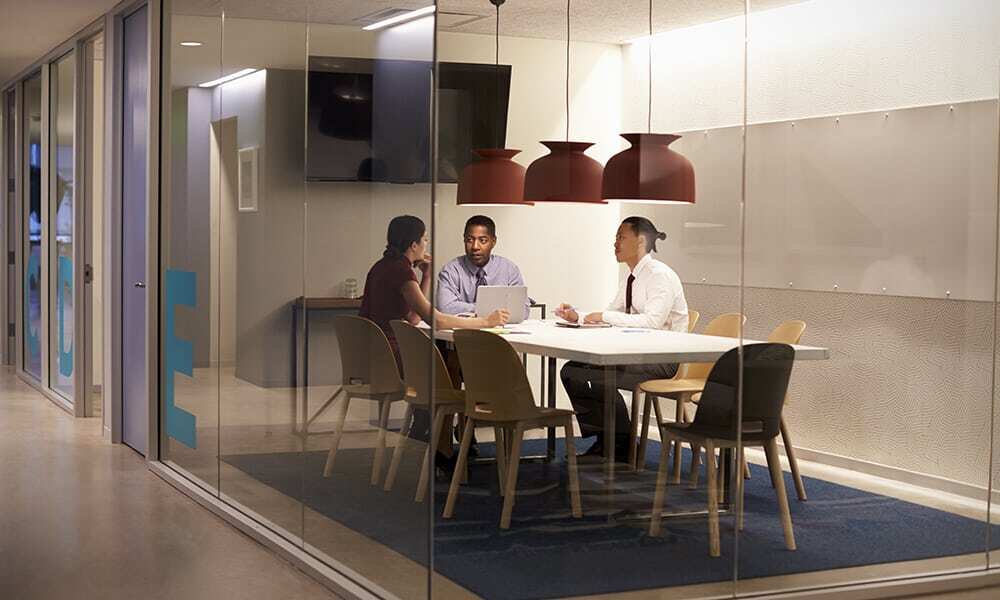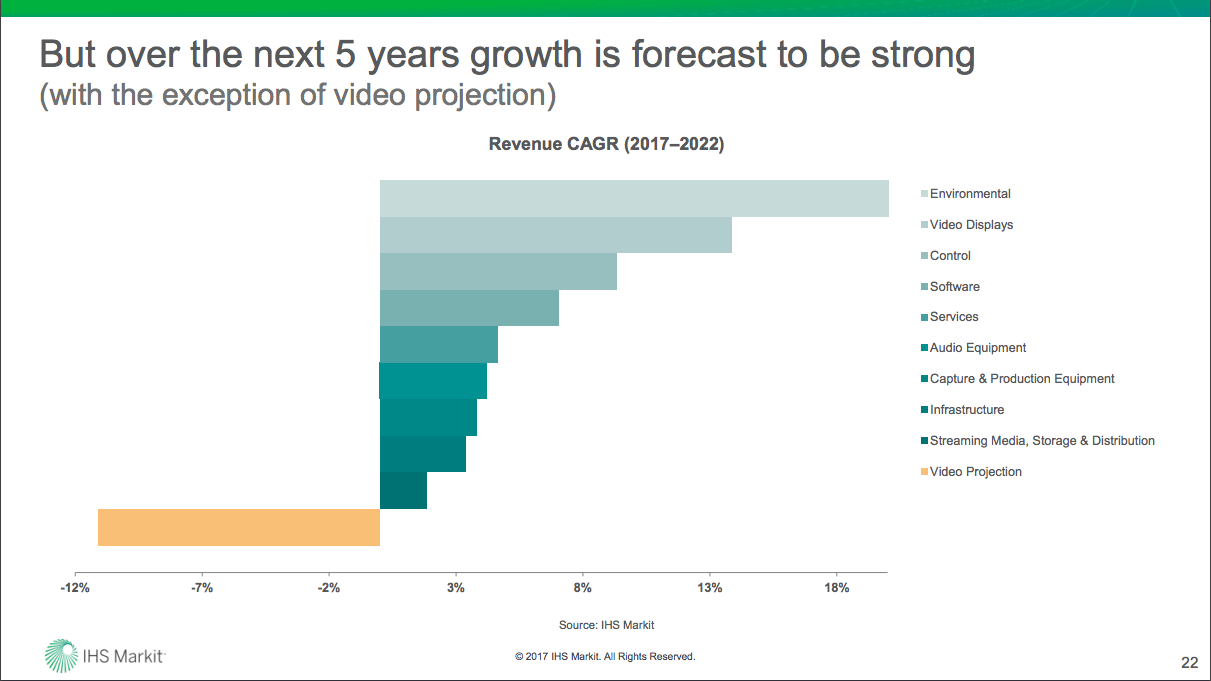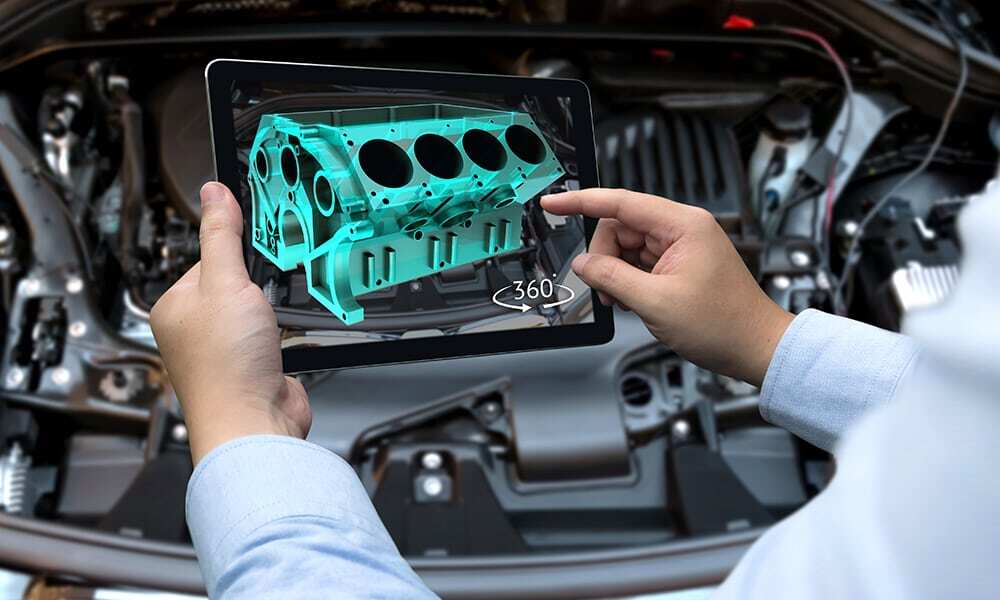Editor's note: This post was updated on Jan. 31, 2018.
The constant yearning for innovation and what's next has created a break-neck environment in the technology industry, which has spurred advancements in the past year that are going to impact consumers, manufacturers, and integrators in 2018.
There has been a lot of movement over the past year. However, there are a few things that seem to really stand out, artificial intelligence included. There are also some things from 2017 and prior that are fading out.
Who knows, maybe we'll see some longstanding trends completely fizzle out?
And, in the mix of it all are some trends and technologies that are headed into 2018 with real potential, even though they haven't always done quite as expected.
What’s Trending and Emerging in the Pro AV and Broader Tech Space?
While some trends are on their way out the door in 2018, many are taking off. And, it’s about time.
What’s playing into all of these trends is the demand for an “experience economy,” said Sean Wargo, senior director of market intelligence at AVIXA.
“In other words, a lot of what we are seeing translates into clear advancements in the ultimate consumer experience being offered by businesses in any given vertical market,” Wargo said in an email.
He gave the retail industry as an example.
Online shopping has swept up the market. The Pew Research Center reported that 79 percent of Americans shop online, and 34 percent of all Americans say they prefer online to in-store shopping.
Wargo said that given the spur in online shopping, it’s left brick-and-mortar stores searching for innovative ways to engage customers. Stores need a differentiating factor.
“AV plays a large part in this,” Wargo explained. “The same is true across so many verticals, including hospitality, transportation, education, live events, healthcare -- pretty much everywhere.”
It comes down to this experiential approach, he said, and it’s exciting in many ways.
“The opportunities within it are huge and long-lasting since the level of creativity and skill required should translate into differentiation for entrepreneurial AV professionals,” he said.
Taking this into account, along with industry forecasts, integration trends, and more, here’s what we foresee happening in 2018.
Voice Command and the Power of Artificial Intelligence
In light of AVI Systems’ 2017 National Sales Meeting, the James Bond-like technology is becoming more and more a part of people’s daily lives.
Smartwatches came on the scene a few years ago, and they’ve been nice – for the most part – but what’s really beginning to take root is voice command powered by artificial intelligence.
Amazon Alexa, Google Home, your iPhone or Android, all of these devices and others can help you look up the weather, order groceries, or organize a meeting.
In 2017, voice gained enough traction and usability to garner the attention of technology-hungry consumers. And now, moving into 2018, the momentum is only going to continue.
“We’re going to remember that as the year voice took off,” said Dave Hatz, application development lead at AVI Systems. “In 2017, it was all about Amazon Alexa and Google Voice everywhere.”
Hatz explained that in 2018, the focus is going to be on what voice command can do for you.
“I also hope in 2018 there is the combination of security and voice control, especially in the commercial space,” he said.
From an integrator’s point of view, Hatz said that he makes it known to clients that while the blue ring is on, whatever is said is going to Amazon’s servers. So, for those who deal with sensitive information, it’s prudent to think twice before installing a device like Alexa or the Google Home in your boardroom.
“There’s a low probability that things will leak out … but, there’s no guarantee,” Hatz said. “We always joke about it, we always say Alexa is always listening.”
With that idea in mind, the conversation of security and voice command is going to come up more and more, Hatz said.
Securing your technology – and your life
Speaking of security, I’m sure your stomach dropped – just like mine did – when you heard that the information of over 145 million people was compromised in the Equifax breach in 2017.
That could be your name, social security number, birth date, address, maybe more.
The anxiety kicked in, I’m sure.
For many, it meant freezing their credit and perhaps dealing with a nasty cleanup.
Unfortunately, that wasn’t the only instance of a cybersecurity threat. WannaCry (or, WannaCrypt) dominated headlines for days, weeks, as cybersecurity experts worked day-in, day-out to catch the hacker behind the act. WannaCry affected businesses, banks, law enforcement agencies, and many others all around the world.
With so much uncertainty in what could happen next, cybersecurity and the importance of having adequate encryption in 2018 will become even more deeply rooted in the lives of everyday people and businesses alike, especially as technology becomes integrated into nearly every aspect of life and work.
We reported earlier this year that the average cost of a cyber breach is around $200,000 for businesses. For those that still have legacy systems in play, the vulnerability is even greater against a sophisticated cyber-attack.
Protecting data and protecting employees will rise in priority in 2018, because in some cases, it’s not a matter of if, it’s a matter of when.
Video Streaming over IP
Similar to voice command, video streaming over IP gained a real hold in 2017 in the Pro AV industry.
Video over IP, or IPTV, is a way to broadcast live or on-demand video over a broadband network. At the root of it all, it’s really just another way to get video from point A to point B.
Some manufacturers have been talking about this idea for the past decade or longer, said Hatz, with AVI Systems.
“We’ve been talking about it for the past 10 years,” Hatz said. “I really think 2017 was the year it took off. Now, it’s something being considered more often. I think 2018 will see that continue on.”
The transition from composite video to a fully digital landscape did create some bumps in the road, causing hesitation to adopt an IP-based system.
“It’s not this black magic voodoo,” he said. “Streaming just becomes another means to move video around.”
What’s more, streaming video over IP has many added benefits to businesses and organizations.
We published a blog post in December 2017 about IPTV and why it matters. Read it here.
In some ways, it’s more cost effective because you don’t have to invest heavily in overhauling technical infrastructure in order to distribute video to multiple devices.
It also enables mobile viewing and distribution. Just think, you can watch Netflix at home, in the airport, on the bus, on your lunch break, anywhere really.
Related Video
AVI Insight is your all-powerful communication technology management tool – the industry’s first multi-platform, multi-vendor, real-time monitoring and reporting system.
Predicting the Future
Futureproofing can be difficult because technological change and development are constant – literally. But, that doesn’t mean that long-term solutions can’t be found.
From an integration standpoint, it’ll be even more important to find solutions that will last long-term for clients as a means to continue adding value to the design, the function, and the support of a system.
With that in mind, it’ll come down to working with clients to build out a solution -- including AV-as-a-Service (more on that below) -- that works to their needs in a way that can scale and adapt with different work environments and styles, and, of course, varying devices and software.
Not only will futureproofing systems help save time and money for clients, it’ll allow for long-term partnerships to mold and flourish. Less time will be spent replacing and developing new solutions, and more time will be dedicated to supporting the systems and increasing the efficiency.
Tech Trends That Are Fizzling Out
It’s awesome to see seemingly futuristic technology like artificial intelligence come into the spotlight in 2017, with a great deal of potential going into 2018.
However, equally important to take notice of is what’s not so awesome anymore.
There are some trends from 2017 and prior that are fizzling out. It might just be that we see the final days of some longstanding trends in the tech space.
And then again, maybe not.

Downsizing Meeting Rooms, Adding Agility
“We have seen a lot of customers move to more huddle rooms instead of larger, integrated conference rooms,” said Mike Wallin, design engineer II at AVI Systems. “There will still be a space for the integrated room, especially boardrooms and higher [executive] type spaces, but we are seeing more and more companies putting huddle-based technologies in.”
What’s happening with this transition is the long boardroom table has faded into the background, while shorter tables with BOYD (bring your own device) hookups, smartboards, and enough wide-open thinking space move into the foreground.
Huddle spaces provide employees with a great deal of flexibility when it comes to off-the-cuff collaboration, especially in comparison to a decked out boardroom.
Every company is different though. With that in mind, every team within the organization operates differently too. So, what works for one team in one company might not seem right to another elsewhere.
The moral of the story: If boardrooms are working for you, why change?
It’s just that boardrooms often go underused, which means that expensive investments in technology are in vain because nobody is actually using what’s been provided.
When this happens, huddle rooms can save the day because the investment often doesn’t equate to that of an executive boardroom, and it offers greater flexibility for teams.
[Related Blog Post: Why Huddle Rooms Are the Way to Go]
Video Projection Expected to Decline 11%, Report Says
IHS Markit and AVIXA hosted a joint webinar to explain their findings featured in the “Audiovisual Industry Trends: 2018 and Beyond” report.
The headliner for the report is very reassuring for anybody in or planning to join the industry. The report shows that by 2022 the Pro AV industry is expected to swell to $230 billion.
Woah is right.
Within the report, it detailed the forecasted growth for different areas within the Pro AV industry, including services, video displays, control, software, and more.
All areas show modest to strong growth expectations over the next five years, with the exception being video projection. Video projection is expected to take an 11 percent decrease in revenue.
On the flip side, however, video displays are expected to increase about 14 percent in sales over the same timeframe.
 Photo Credit: IHS Markit, AVIXA
Photo Credit: IHS Markit, AVIXA
What's Emerging in the Pro AV space?
AVaaS (AV-as-a-Service)
“AVaaS will be HUGE,” wrote Gary Kayye, founder of rAVe Publications, in an article. “AVaaS will be THE BIG THING everyone starts to talk about in 2018 and it’s my pick for the biggest new trend for the new year.”
What is AVaaS?
AV-as-a-Service is just as it sounds. Companies and integrators provide audiovisual technology on-demand for customers when and how they need it.
Similar to SaaS (Software-as-a-Service), customers pay for services on a regular basis, whether monthly, quarterly or annually, for a system, like a video conferencing setup or a huddle room.
Some of the biggest advantages of AVaaS, according to Kayye, is that it standardizes the technology used by customers, which makes it easier to support, predict usage, fix any issues, and generally maintain. It also creates an ongoing relationship between the tech company and the customer because it's not just a single transaction but an ongoing partnership.
IT and the Cloud
“In terms of the most promise or potential, IT and Cloud are huge,” said Wargo, with AVIXA, in an email. “We are already showing streaming media, distribution, and storage technologies as the largest technology segment of the pro-AV space.”
Since these aren’t “traditional” AV technologies, there’s a bit of controversy there. “But, so many solutions rely on distributed content served from either on premises or virtual servers (such as digital signage) we could not ignore their contribution to the total industry,” Wargo explained. “Many of these are commodity IT products which have become essential AV components over the past decade.”

Augment Reality and Virtual Reality
The stuff that you can do with augmented reality (AR) is pretty amazing.
Although, immediately, it’s hard not to think of Snapchat filters or even Pokemon Go from a few years ago.
How much further has AR come along? It made an impact in a big way when it came on the scene through some channels, but what else is in store – if anything – for AR?
“There is potential with these technologies,” said Wargo. “It is just uncertain exactly how they will be utilized across the various application areas.”
Aside from gaming and social media, AR could be a huge asset to AV professionals during installations and post-installation support by cutting hours on-site and making remote and virtual support even more commonplace.
Wargo pictures AR having a great deal of potential, but it still has a lot of ground to cover before it reaches large-scale adoption.
Virtual reality is the same way.
Doctors have used virtual reality to save lives in extraordinary ways. The gaming industry has taken hold of VR to give players an almost too real experience. You can also sit in your new car or walk through an open house without leaving the couch.
But, the technology has struggled to take off in the way many imagined it would. That might change in the coming year though.
The virtual reality market is expected to grow to about $27 billion by 2022, according to Zion Market Research. And, spending on AR is expected to grow to $60 billion in 2020, the Harvard Business Review reported.
With all of this expected growth and adoption, it’s anybody’s guess at why these technologies haven’t hit the ground running earlier.
Price is often an issue, sure. The development might be a bit awkward too, but is that really the biggest deterrent?
Well, at any rate, AVI Systems reported earlier this year that the adoption of VR among millennials has a good outlook. And, with AR becoming more sophisticated with time, this too will take up more market space. In 2018, we'll see these technologies grow and become refined, with the expectation to finally take off in the coming years.
Let’s be real, what’s really next?
Frankly, it’s anybody’s guess.
Technology changes rapidly – like, really rapidly. It’s incredible to see the breakthroughs in technology, even if it’s dizzying at times.
What’s certain, though, is that we can expect to see great things come out of the Pro AV and broader technology markets this year as innovations and predictions run wild.









